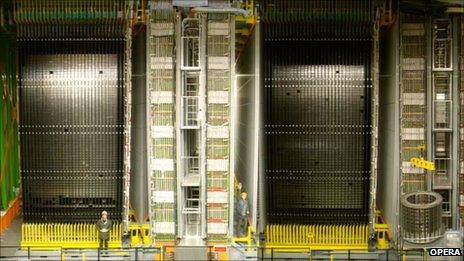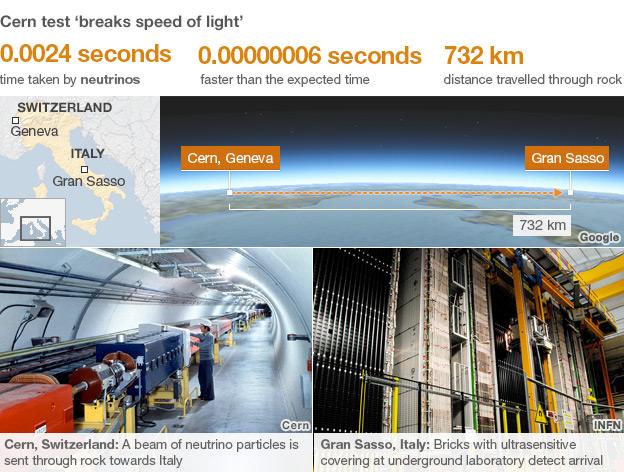Speed-of-light results under scrutiny at Cern
- Published
- comments

Enormous underground detectors are needed to catch neutrinos, that are so elusive as to be dubbed "ghost particles"
A meeting at Cern, the world's largest physics lab, has addressed results that suggest subatomic particles have gone faster than the speed of light.
The team has published its work, external so other scientists can determine if the approach contains any mistakes.
If it does not, one of the pillars of modern science may come tumbling down.
Antonio Ereditato added "words of caution" to his Cern presentation because of the "potentially great impact on physics" of the result.
The speed of light is widely held to be the Universe's ultimate speed limit, and much of modern physics - as laid out in part by Albert Einstein in his theory of special relativity - depends on the idea that nothing can exceed it.
Thousands of experiments have been undertaken to measure it ever more precisely, and no result has ever spotted a particle breaking the limit.
"We tried to find all possible explanations for this," the report's author Antonio Ereditato of the Opera collaboration, external told BBC News on Thursday evening.
"We wanted to find a mistake - trivial mistakes, more complicated mistakes, or nasty effects - and we didn't.
"When you don't find anything, then you say 'well, now I'm forced to go out and ask the community to scrutinise this'."
Friday's meeting was designed to begin this process, with hopes that other scientists will find inconsistencies in the measurements and, hopefully, repeat the experiment elsewhere.
"Despite the large [statistical] significance of this measurement that you have seen and the stability of the analysis, since it has a potentially great impact on physics, this motivates the continuation of our studies in order to find still-unknown systematic effects," Dr Ereditato told the meeting.
"We look forward to independent measurement from other experiments."

Neutrinos come in a number of types, and have recently been seen to switch spontaneously from one type to another.
The Cern team prepares a beam of just one type, muon neutrinos, and sends them through the Earth to an underground laboratory at Gran Sasso in Italy to see how many show up as a different type, tau neutrinos.
In the course of doing the experiments, the researchers noticed that the particles showed up 60 billionths of a second earlier than they would have done if they had travelled at the speed of light.
This is a tiny fractional change - just 20 parts in a million - but one that occurs consistently.
The team measured the travel times of neutrino bunches some 16,000 times, and have reached a level of statistical significance that in scientific circles would count as a formal discovery.
Professor Antonio Ereditato of Cern: "An understatement that these are unexpected results"
But the group understands that what are known as "systematic errors" could easily make an erroneous result look like a breaking of the ultimate speed limit.
That has motivated them to publish their measurements.
"My dream would be that another, independent experiment finds the same thing - then I would be relieved," Dr Ereditato told BBC News.
But for now, he explained, "we are not claiming things, we want just to be helped by the community in understanding our crazy result - because it is crazy".
- Published23 September 2011
- Published15 June 2011
- Published23 March 2011